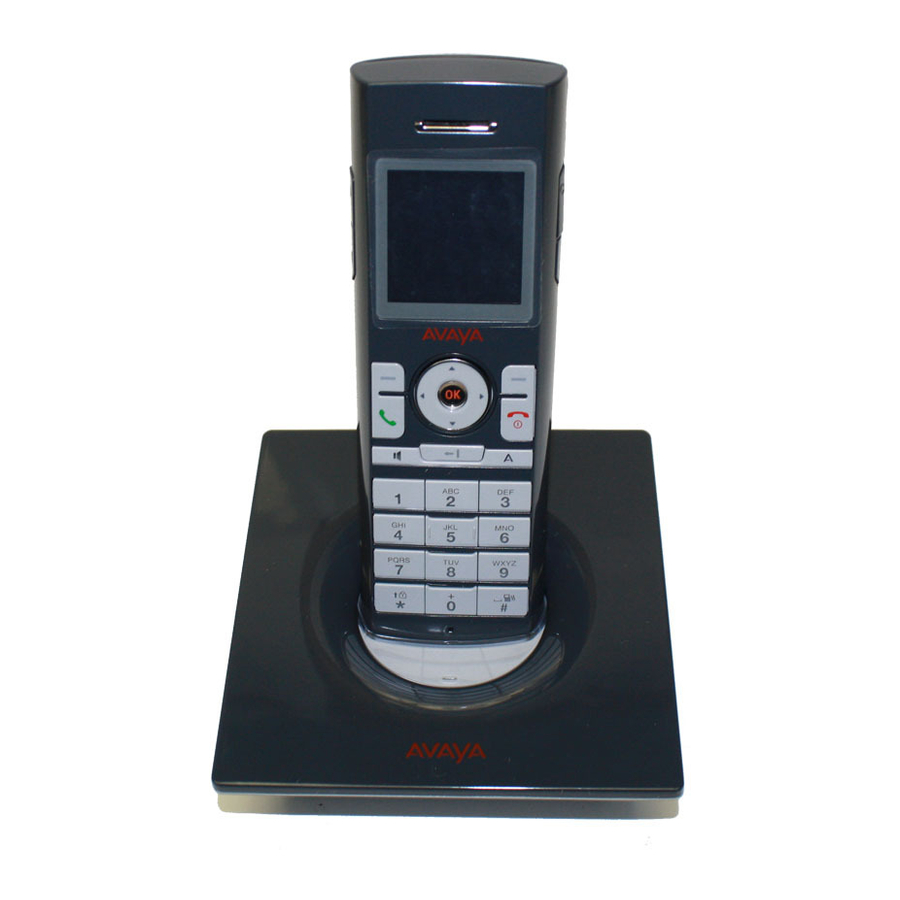Avaya 3641 Kurulum Kılavuzu - Sayfa 12
Telefon Avaya 3641 için çevrimiçi göz atın veya pdf Kurulum Kılavuzu indirin. Avaya 3641 19 sayfaları. Co-existence with ip wireless handset offering
Ayrıca Avaya 3641 için: Hızlı Referans Kılavuzu (2 sayfalar), Kullanıcı Kılavuzu (2 sayfalar), Yapılandırma Kılavuzu (8 sayfalar)

Installation Guide
or dynamically using standard DHCP protocol. The Avaya Handset Configuration Cradle can be used to
quickly load and change administration options in the Avaya wireless telephones including static IP
addresses. For dynamic IP addressing, a DHCP server is required.
Avaya Voice Priority Processor (AVPP) also requires an IP address and supports either static or DHCP
address assignment. When using one or more AVPP(s), one AVPP will serve as the Registration AVPP
and must be assigned a static IP address. The Registration AVPP IP address should be designated in
the DHCP scope for the handsets.
3.3 Software Updates Using TFTP
The Avaya wireless telephones and related infrastructure are field-upgradeable in terms of new software
features or capabilities and bug fixes. Avaya wireless telephones and AVPP utilize a TFTP client to
automatically download new code when available. Ideally the TFTP serving software updates will be
located on the local network and not over a WLAN connection.
4.0 Quality of Service
4.1 Avaya Voice Priority Processor (AVPP)
Quality of service (QoS) is a means of providing a level of service that will result in a network
connection of acceptable quality. Typically this results in providing different levels of service for
different applications, depending on their requirements. When data and voice are competing for
bandwidth, it is necessary to have a prioritization method that provides a controlled preference to voice
packets. The initial 802.11 standards did not provide a practical QoS mechanism, so Avaya utilized the
AVPP to allow delay-sensitive voice and asynchronous data applications to coexist on a Wi-Fi network
without compromising voice quality.
Good voice quality is ensured on a shared network with an AVPP, which is fully compatible with Wi-Fi
networks. Supported by the leading AP vendors as the de facto standard for voice QoS, the AVPP
guarantees audio quality in a shared voice and data network. Access points generally use random
back-off intervals and require all types of traffic to contend for access to the wireless medium with
equal rights. However, treating all traffic equally can cause significant delays to voice traffic. Modifying
the AP behavior to recognize and prioritize voice packets increases the probability of better
performance while continuing to treat asynchronous data packets normally. The two operations that
comprise AVPP compliance in the AP, minimizing random back-off and priority queuing, require a
packet-filtering mechanism. Packet filtering requires recognizing the packet's type. Avaya wireless
telephone packets are registered as protocol ID 119 at layer 4. The AVPP also performs packet
delivery timing through the AP to the wireless telephones, which is critical for ensuring seamless
handoffs among APs and for enhanced battery management. The following section offers a more
detailed explanation of timed delivery.
4.1.1 AVPP Infrastructure
To trigger AVPP functionality in the APs from the wired side of the network at least one AVPP is
required. A model AVPP-010 or AVPP-020 can support smaller installations however at least one
AVPP-100 is required for applications using greater than 80 handsets.
4.1.2 AVPP Capacity
A single AVPP-100 supports 80 simultaneous calls. Multiple AVPP-100s can be used to increase
capacity to support up to 850 total calls (which can support approximately 8,000 wireless telephones.)
For smaller IP telephony interface deployments, 10 and 20-user AVPPs are also available. Refer to
the AVPP administration guide for additional information regarding the maximum number of
simultaneous calls and wireless telephones supported by multiple AVPPs.
Octiober 2008
12
